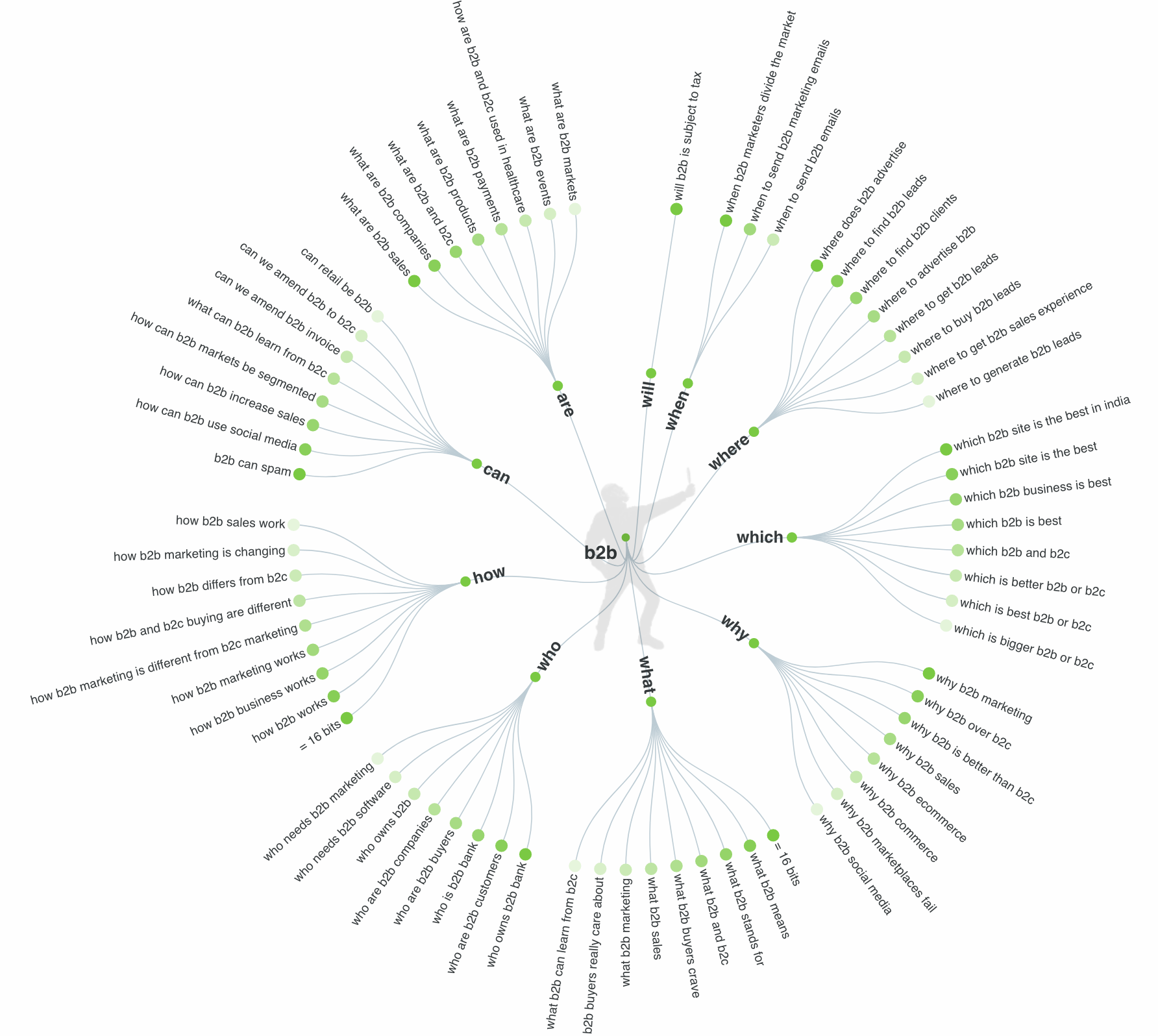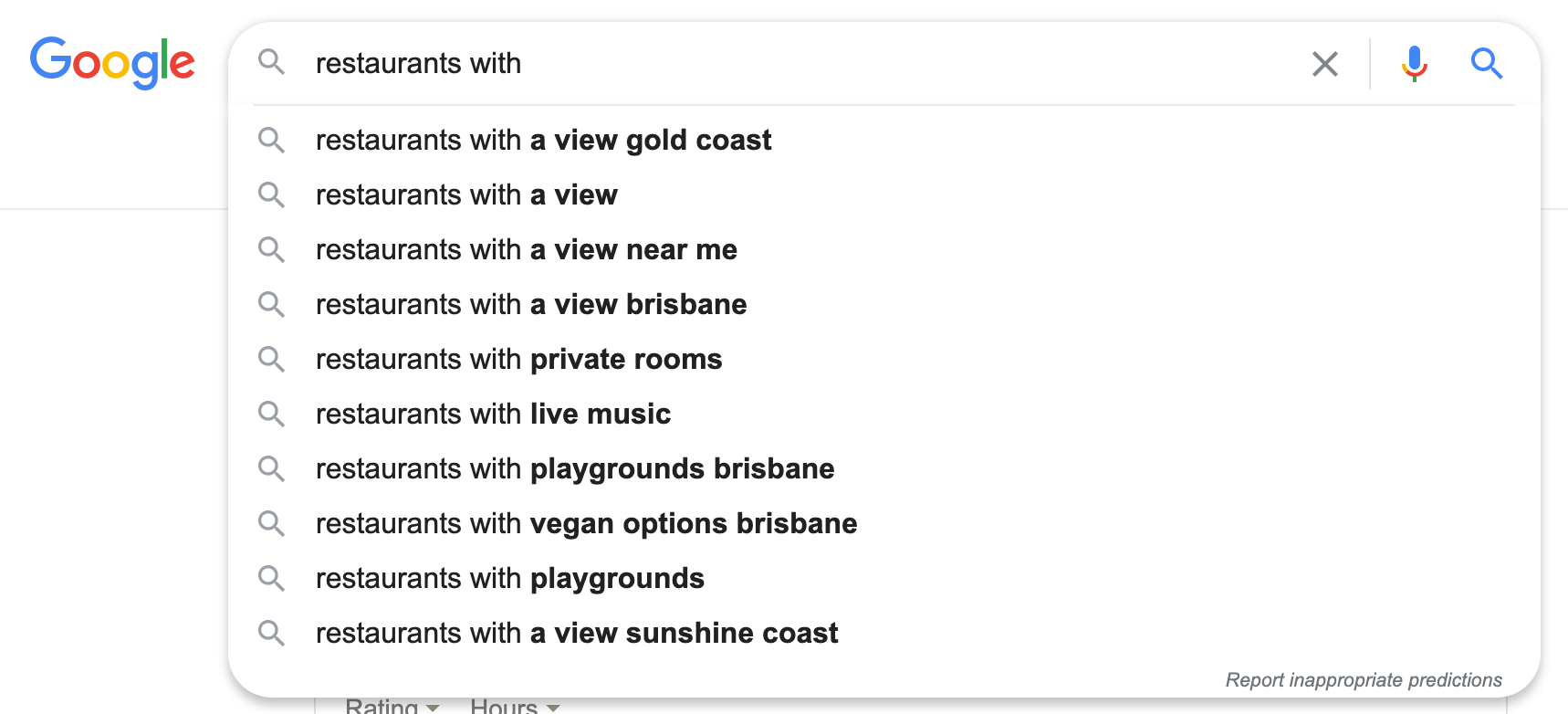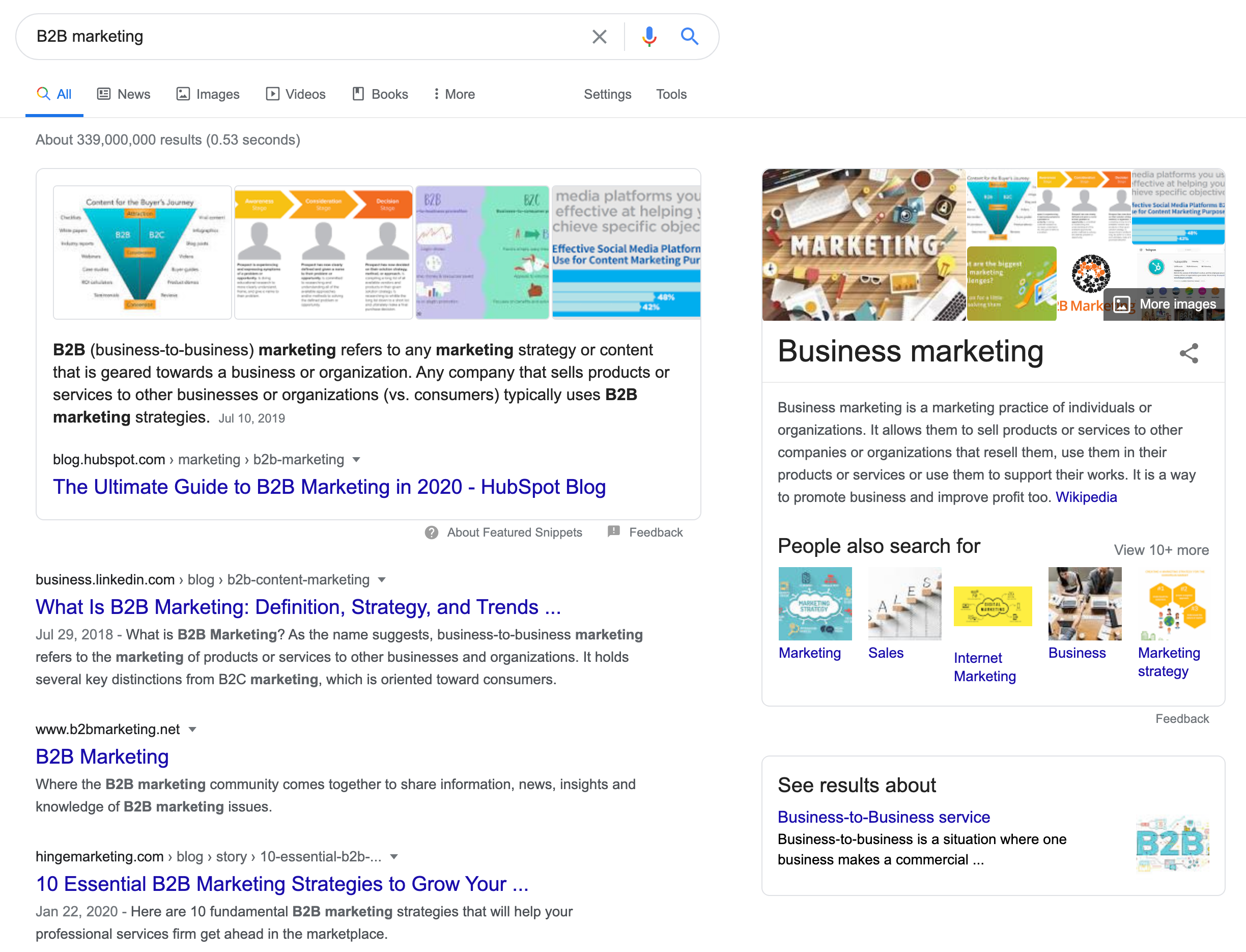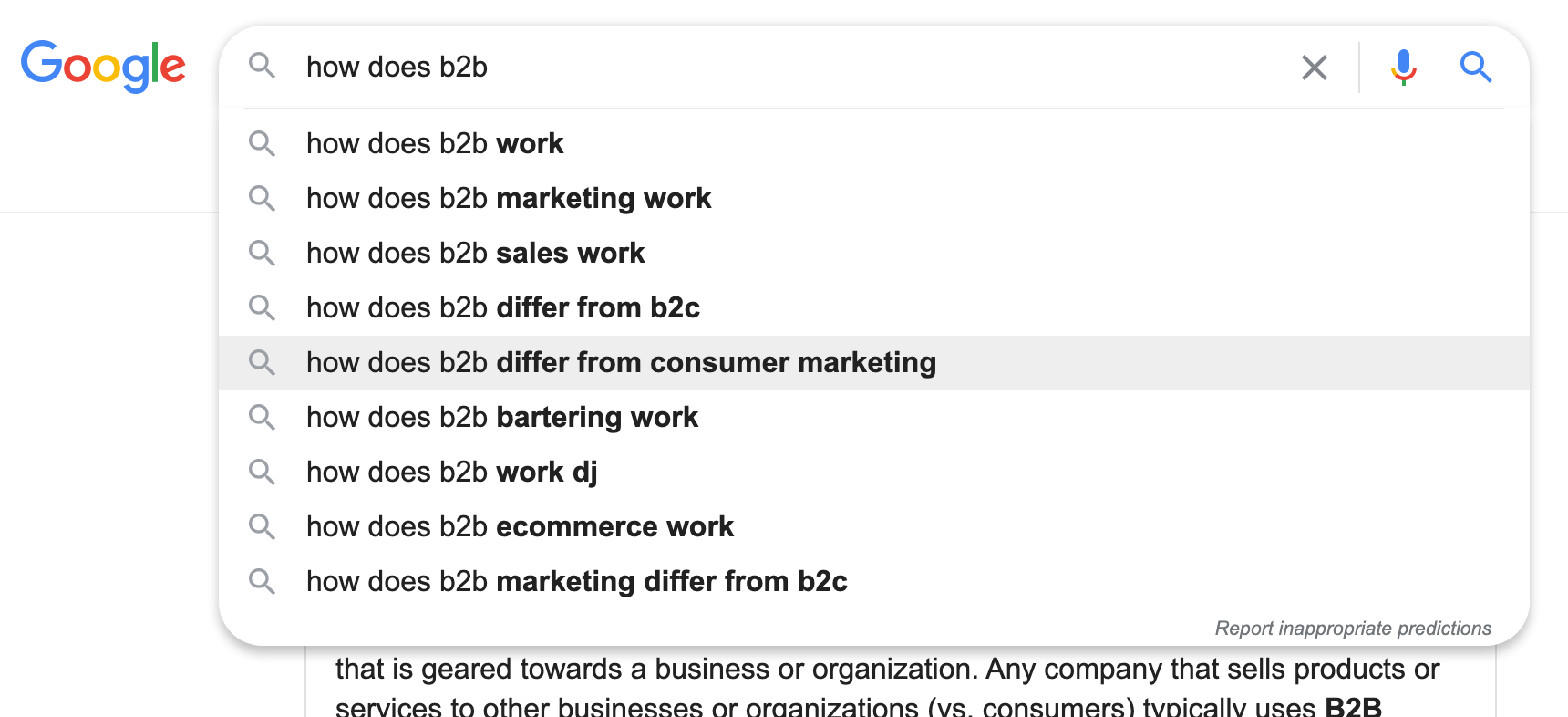
16 May How To Understand Exactly What People Want
Do you find yourself struggling to understand what it is potential customers want?
Perhaps you thought you knew, but they aren’t engaging.
In this guide, I’ll take you through the theory behind answer-based marketing,
then, I’ll show you how you can understand consumer needs yourself, at no cost.
You’ll see why asking; who, what, where, why, when, which, how and can, are able to reveal incredible insights.
The reality; almost every single digital journey is unique.

Here, we just how unique each querey can be
Not a single person on this planet uses search or social media in the same way.
Nor do are they at the same life stages or experience the same problems.
We have quite unique paths to purchase.
Yet a lot of marketers forget this and often get caught up in high volume, broad keywords.
Keywords that essentially relate to their own digital journey.
Take the search query “B2B marketing” for example.

B2B Marketing search querey in Google
It’s really difficult to understand what a person truly wants here because it is so broad.
Therefore it is easy to misinterpret the actual reason for the search.
The biggest challenge marketers face is not only knowing that their audience wants,
but also creating content that is powerful enough to cater to those needs.
In many ways, this has been true since the sixties.
But the thing it doesn’t have to be so daunting.
Better still, a solution to these challenges is something that I can almost guarantee,
you do yourself already on a regular basis – and that’s using Google.
In this day and age, when people need answers to questions they don’t know, the vast majority of people will Google it.
In fact, every 10 seconds Google receives over 650,000 search queries
That’s a hell of a lot of questions.
But more to the point, that’s also a hell of a lot of FREE marketing information.
Alright, that might sound a bit far-fetched.
But when people search in Google, asking questions they need answers to,
they’re essentially telling Google, what their exact intent and interests are at that particular time.
How? By asking Google to provide them with exactly what it is they want, need or desire.
Basically, they’re providing Google with information of their exact pain points…which…let’s face it…is a marketer’s dream!
This information is so powerful to marketers because it is the only marketing channel where people are completely open and receptive about their needs.
Most other channels are interruption-based, with the exception of social…which is interest-based.
And to reiterate the point earlier, this information is provided freely at the will of the people searching for answers!
The only requirement is that the people have to ask the right questions first,
And that’s where question analysis comes into play.
What is Question analysis?
Question analysis is the process of understanding intent, or content of a question.
By understanding the context of the questions asked that are being of Google,
you can then start understanding the exact wants, needs, and desires of your audience.

Question analysis in Google starts with you
And only by performing question analysis can you truly answer those needs.
This is done by ensuring your content, or product caters to the questions people ask.
This is where AEO comes in.
What is AEO?
AEO stands for Answer Engine Optimisation.
Search engines, like Google, are now to providing direct answers to questions (as opposed to links) via voice assistants such as Alexa, Siri or Google Assistant.
AEO is the process of answering questions better in order to increase a brand or websites, chances of being chosen as the best, or correct, answer.
This essentially removes the need to ‘search’ in a traditional sense. Therefore, the key to success is about
How To Understand Exactly What People Want?
To answer that, first, we’ll take a step back and talk briefly about Google’s autocomplete.
If you’re not already aware, Google has a database that has been built up from billions of searches.
It uses this database to predict what it is you’re going to ask, based on the initial word (or words) you’ve entered in the search bar.
Google Search Bar

Question analysis in Google starts with you
By entering in different variations of the keywords, Google will generate more and more ideas for content.
And best of all, Google will only show you relevant suggestions if there is a search volume behind that query.
This gives you the confidence that people are actually searching for the query before you decide to produce content.
It’s practically a marketer’s social proof.
The only issue with this method is that it can be very tedious and requires a lot of manual data entry.
But thanks be to the Millennials – there’s now an app for that.
These days there is an app or tool for almost anything, and of course, everything has to be automated.
And this is where Answer the Public wins hands down!
Basically, Answer the Public is an automated suggestion scraper & visualisation tool.
It follows the process mentioned above but does all the hard work for you.
And better still, it takes the results and displays them separately through the different variations of questions that can be asked.
E.g. The “how’s” are separated from the “what’s”, which are separated from the “why’s”, etc.…
It does this by displaying all the suggested questions in a downloadable image, easy to integrate into presentations or content.
Using our example earlier of “B2B marketing”, you can see how it delivers the results in a presentable visualisation.

Search suggestion scraping based on fixed parameters
Not only does Answer the Public provide useful questions to give you ideas but it can also generate suggestions based on prepositions, using the keywords at the beginning of the statement or query to generate topics.
That and it also uses comparisons such as “like” and “versus”, as well as an alphabetical search which adds letters to the original query, listing queries or statements that use each letter.
How To Pick A Winning Topic
When you give “The Seeker” the keywords you want to generate ideas for, most of the time he can be overly helpful and provide over 100 suggestions for potential topics.
Realistically, all you need is a few great ideas.
You now know what your audience wants, but how do you go about separating the good from the crap and coming up with a topic that hasn’t been done to death already?
And at the same time completely benefits your audience?
Well, first of all, you need to…
Pick A Relevant Topic
Your goal as a content marketer should be to provide your audience with answers to the questions they have.
And also, to make sure these answers are easily accessible to that audience.
On top of this, to play by Google’s rules, not only does the topic need to be relevant to your audience but also needs to be relevant to your Website and the services you provide.
In other words, if you’re a content marketing company, please don’t give tutorials on how to bathe giraffes, just because you want to target zookeepers or exotic vets!
For this example, we’ll stay relevant and you’ll use the results from the “B2B marketing” search we did earlier.
“What’s B2B marketing?” is certainly a question that requires answering.
But before you invest time in researching and creating content on this topic…you’ll need to find out…
Can You Compete?
By taking your question and putting it straight into Google you should see how well (or not) others are answering the question.
If you genuinely believe that there is room for a better answer…then run with it.
But if you reckon, it would be quite difficult to add any value to what has already been created, then avoid it like the plague and move onto another topic.
Take our example…well…for…example, I suppose!
When put through Google’s search bar we can see the following results…
What’s B2B Marketing Search
Although a question has been asked, it can still be considered broad.
By asking “what’s B2B marketing”, it was answered by a single blog post providing a definition, along with multiple blogs and website with similar variations of the first answer.
This topic has been thoroughly answered.
So, if you really want to provide better answers to your audience, you’re going to have use better questions that were asked.
So, going back to the drawing board over at Answer the Public, you just need to research better questions.
Change it up from a “what’ to a “why” or a “how” question.
Answer the Public How Data
By going deeper into the searches you’re effectively niching down.
Which brings you to the final step
Niching Down
Check out the question “how to do B2B marketing on social media”.
And once again run it through Google.
Now, what do you see?
How to do B2B Marketing on Social Media Search
This brand-new search has provided us with a whole new list of topics, all of which are niche specific.
And remember it’s not so niche that nobody is searching for it, if it was, our mate “The Seeker” wouldn’t have given us the question, if nobody was asking it.
And by looking at this new list of topics it’s plain to see that a lot of this content, while still quite relevant today, some are quite outdated.
That’s where you’ll apply your new-found wealth of knowledge and provide a marketing edge over the existing content.
By researching what is more relevant today and putting your own stamp on it.
Google will still rank content that is a few years old, especially from strongly-built, credible sources.
Providing them with an up-to-date answer to their question, your audience will be more inclined to visit your content.
And although your content should be better (if you value your brand), having an updated post doesn’t automatically make it better.
But in a field where strategies and information are constantly changing and updating, by staying relevantly present, your audience will assume your content is better.
Your job is to make that content better!
A content marketing tip would be to add “2018” to the tile (or whatever year you’re still reading this content – hello people of 2043!)
Not only will this give Google a head’s up that your content is fresh, but also potential new readers.
“The Seeker” Has Spoken!
By using Answer the Public to take the free information that Google collects, you can find better questions that are being asked by your audience, to research and create better content for them.
But always remember that while creating this content, you’ll need to provide better answers than your competitors to your audiences’ pain points.
And also, better answers than the content that is currently available.
The best part of all of this is, you can do is by utilising the free software and free information mentioned above.
By asking who, what, where, why, when, which, how and can, we also understand more about the concerns or interests of the people as they go through their unique digital journey.



No Comments